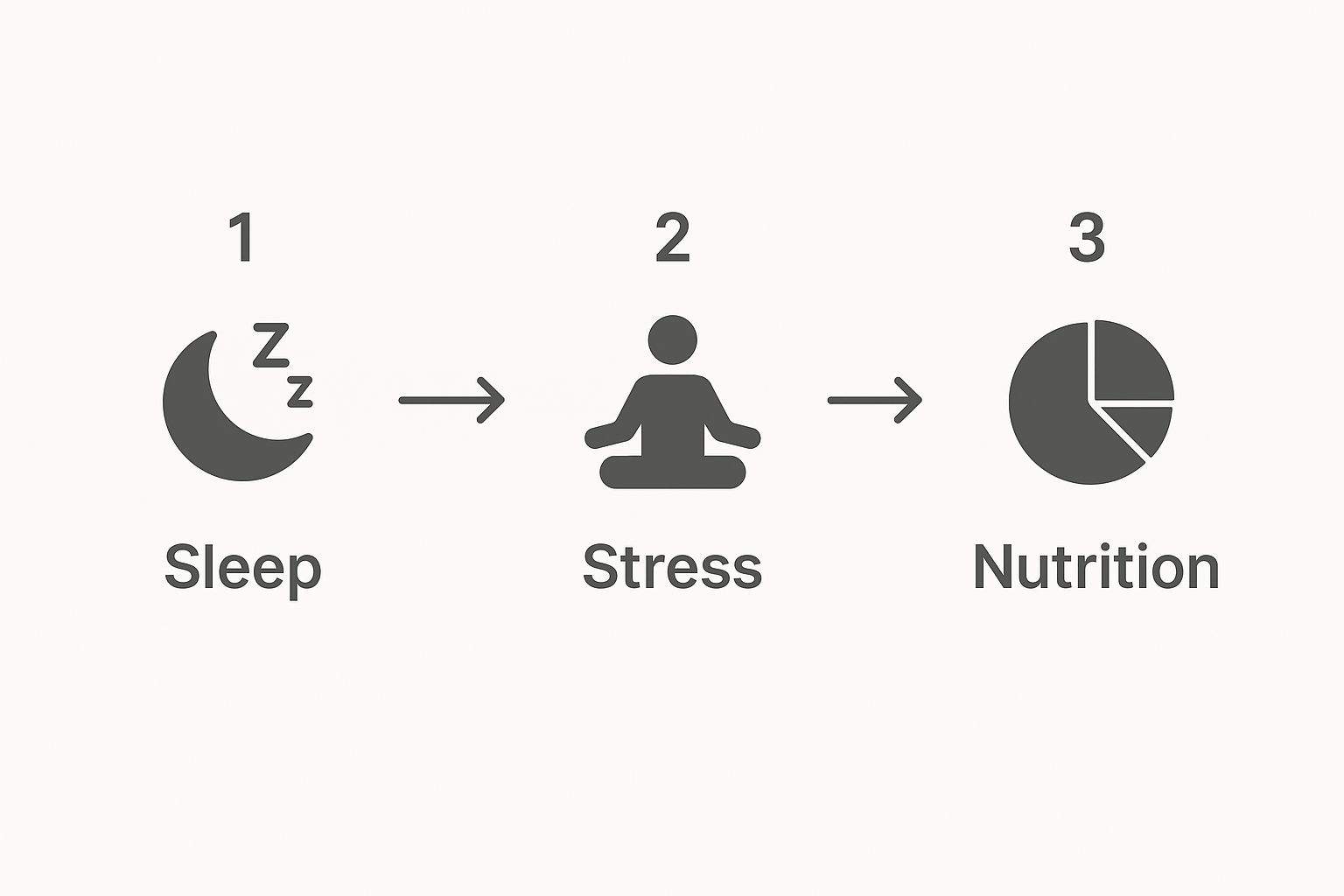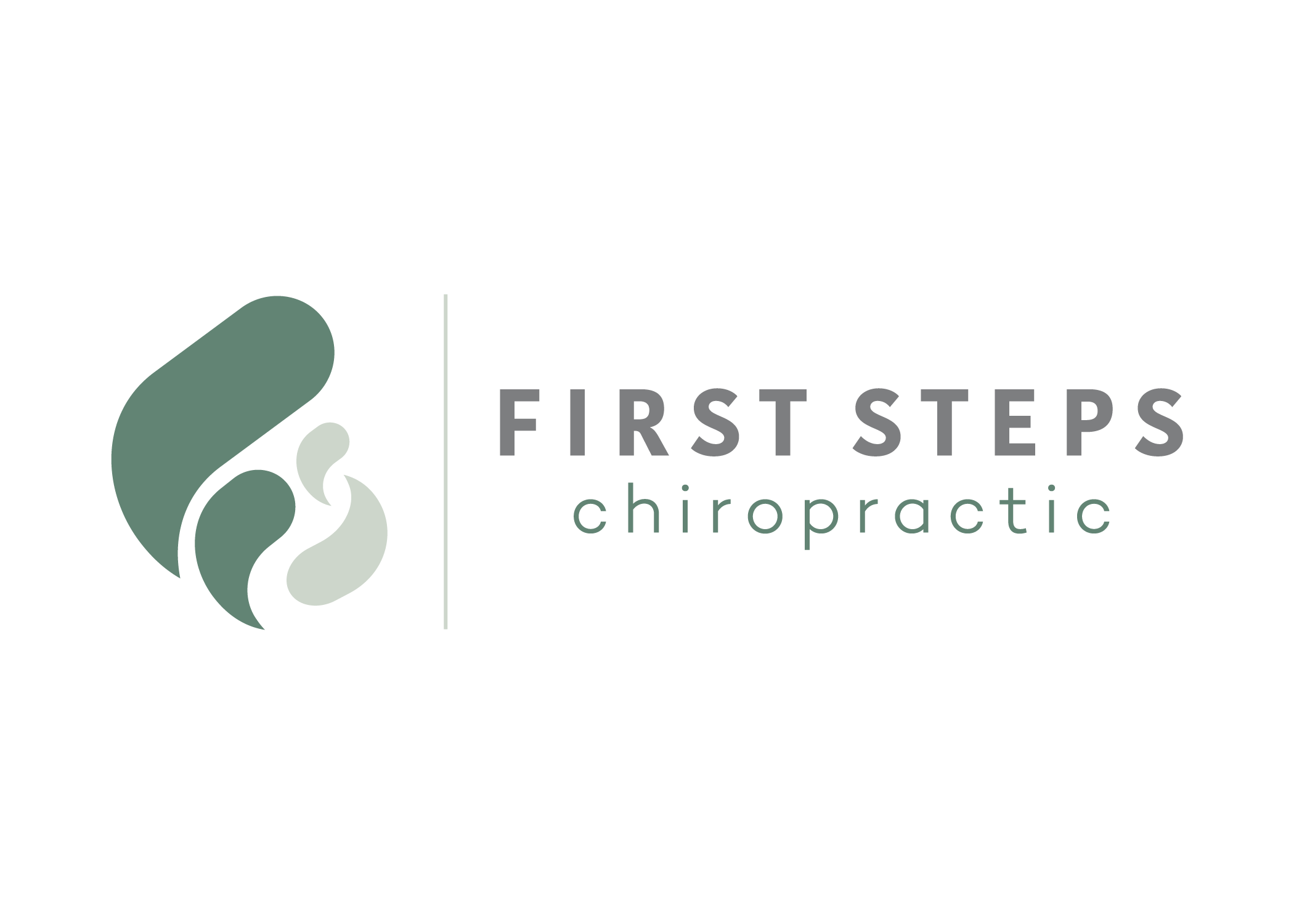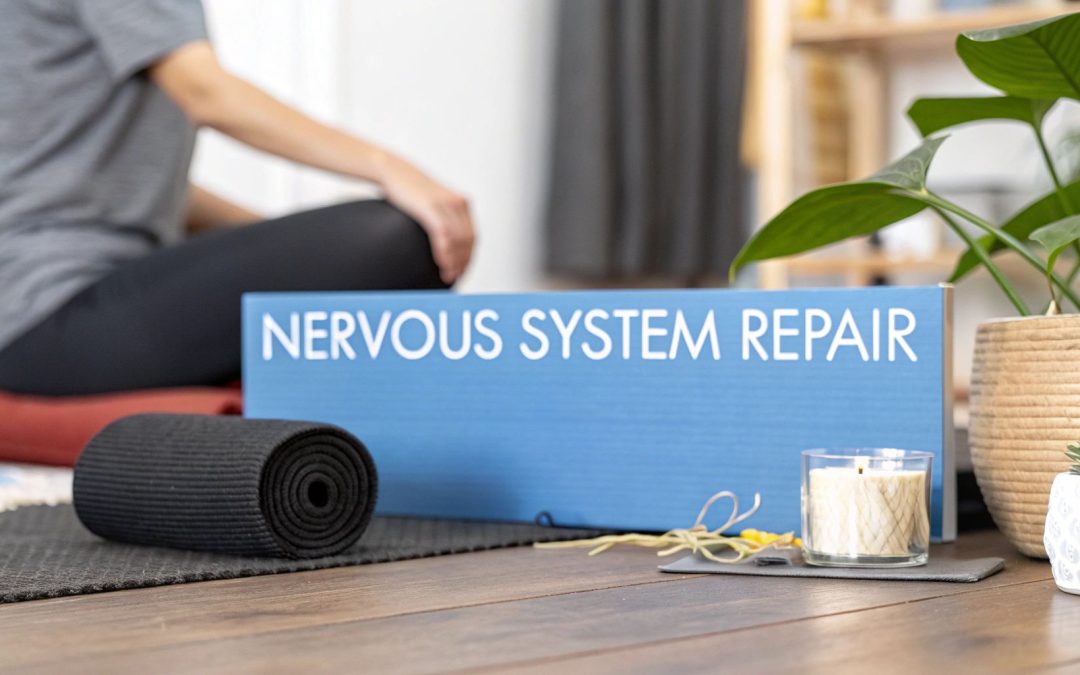Before you can begin to repair your autonomic nervous system, you have to learn to listen to its signals. It's that nagging anxiety that won’t quit, the bone-deep fatigue that sleep doesn’t fix, or the digestive system that feels completely chaotic. The healing process is all about calming that overactive 'fight-or-flight' response and giving the 'rest-and-digest' system a chance to take over through consistent, mindful practices.
This guide will help you connect the dots between your symptoms and an imbalanced nervous system, giving you real, actionable steps for long-term recovery.
What It Feels Like When Your Nervous System Is Unbalanced

Before we get into the how of repairing your autonomic nervous system, it’s crucial to recognize the signals your body is already sending. So many people live with these signs of imbalance for years, and eventually, it just starts to feel normal. That constant hum of anxiety, the exhaustion that a full eight hours of sleep can't touch, or the unpredictable gut issues just become part of daily life.
The autonomic nervous system (ANS) is your body’s silent conductor. It manages everything from your heart rate and breathing to your digestion and body temperature without you ever having to think about it. It operates through two main branches that act like a seesaw, working to keep you in balance.
- The Sympathetic Nervous System: This is your 'fight-or-flight' response. Think of it as the gas pedal. It revs you up when you sense danger, flooding your body with adrenaline and cortisol. Your heart races, muscles tense, and your focus sharpens.
- The Parasympathetic Nervous System: This is your 'rest-and-digest' system—the brake pedal. It slows everything down, promoting calm, recovery, and healing. It helps you relax after a stressful moment passes, digest your food properly, and get deep, restorative sleep.
In a healthy, well-regulated system, these two branches work together beautifully. You ramp up when needed and calm back down when the threat is gone. Dysregulation is what happens when that seesaw gets stuck.
When Fight or Flight Becomes the Default
For many of us, the sympathetic nervous system stays in the driver's seat way too long. Modern life—with its endless deadlines, constant phone notifications, and social pressures—keeps that gas pedal floored. Your body can’t really tell the difference between being chased by a lion and facing a stressful board meeting; the physical response can be strikingly similar.
When this state of high alert becomes your new normal, you start to notice symptoms that might seem totally unrelated but are deeply connected to your ANS. These aren’t just "in your head." They are real, physical signs of an overstimulated system.
A classic example is feeling "tired but wired." You might be physically exhausted, but your mind is racing, making it impossible to fall asleep. Or maybe you get sudden heart palpitations while you're just sitting on the couch, a clear sign your body is still on high alert. To get a deeper understanding of this, you can read our guide on what is a dysregulated nervous system.
The Subtle and Not-So-Subtle Signs of Imbalance
Learning to spot the signs is the first, most important step toward healing. An imbalanced ANS can show up in countless ways and often mimics other conditions, which can make getting a clear answer incredibly frustrating.
Some of the most common signs include:
- Persistent Fatigue: A deep, profound exhaustion that isn't solved by rest.
- Anxiety and Panic: That constant feeling of being on edge, restlessness, or sudden panic attacks out of nowhere.
- Digestive Issues: Unexplained problems like bloating, indigestion, or symptoms of irritable bowel syndrome (IBS).
- Sleep Disturbances: Trouble falling asleep, staying asleep, or waking up still feeling drained.
- Muscle Tension: Chronic pain, especially in the neck, shoulders, and back, from muscles that are always tensed for a fight.
Living with a dysregulated nervous system often feels like you're driving a car with one foot on the gas and one on the brake simultaneously. It's exhausting, inefficient, and ultimately unsustainable for your body's engine.
This constant internal battle drains your physical and mental resources. You might find yourself overreacting to minor things, feeling emotionally numb, or struggling with brain fog that makes it hard to focus. These aren't signs of weakness—they are clear messages that your nervous system is overwhelmed and needs support.
By connecting these dots, you can finally understand the "why" behind your symptoms. That clarity is empowering, giving you the motivation to start the repair process.
Building Your Foundation for Nervous System Resilience
Real, lasting change for your autonomic nervous system doesn't come from a quick fix. It’s built brick by brick, through the small, consistent choices you make every single day. Creating a lifestyle that constantly signals safety and calm to your body is the essential groundwork for everything else.
Think of these foundational pillars—sleep, nutrition, and mindful consumption—as your most powerful tools. They're what help you shift out of that exhausting 'fight-or-flight' mode and into a healing 'rest-and-digest' state. They give your body the biological resources it needs to recover and build resilience from the ground up.
Crafting a Restorative Sleep Routine
We all know we should get more sleep, but when your system is dysregulated, how you prepare for sleep is just as important as the number of hours you clock. The goal is to create a wind-down routine that actively tells your brain and body that the day’s threats are over and it's safe to power down.
It’s all about creating a gentle transition. Jumping from scrolling on your phone or watching an action movie straight into bed can leave your nervous system buzzing. Your body needs clear, predictable signals that it's time to activate that parasympathetic state.
Here are a few specific strategies to build a routine that works for you:
- Dim the Lights: About an hour before you plan to sleep, start lowering the lights in your home. This simple act mimics the natural sunset and cues your body to start producing melatonin, the sleep hormone.
- Warmth and Relaxation: A warm bath or shower can be incredibly effective. It's not just relaxing; the drop in your body temperature after you get out is a powerful, natural trigger for sleep.
- Mindful Disconnection: This one is huge. Put your phone and other screens away at least 30-60 minutes before bed. The blue light and the constant stream of notifications are highly stimulating to an already sensitive nervous system.
Creating a predictable evening ritual does more than help you fall asleep faster. It trains your autonomic nervous system over time, building a reliable pathway back to a calm, restorative state each night.
This consistency is what truly matters. It teaches your body to anticipate rest, making the transition smoother and the sleep you get far more deeply restorative.
Nourishing Your Nerves from the Inside Out
The connection between your gut and your brain is incredibly powerful. What you eat directly impacts your nervous system's ability to function and heal. Chronic inflammation, which is often driven by diet, can keep your body stuck in a low-grade stress state, making it almost impossible to access a true state of calm.
Focusing on an anti-inflammatory diet is one of the most direct ways you can support your healing journey. This means prioritizing whole, unprocessed foods that provide the raw materials for nerve repair and neurotransmitter production.
Some nutrients are especially vital for your nerves:
- Magnesium: Often called the "calming mineral," magnesium is essential for regulating the stress response. You'll find it in leafy greens, nuts, seeds, and even dark chocolate.
- Omega-3 Fatty Acids: These are critical for brain health and taming inflammation. Fatty fish like salmon are fantastic sources, as are flaxseeds and walnuts.
- B Vitamins: These are the workhorses for creating neurotransmitters like serotonin. Good sources include lean meats, eggs, and legumes.
Beyond what you eat, how you eat also sends a message. Rushing through meals while scrolling on your phone sends a major stress signal to your body, shutting down proper digestion. Try practicing mindful eating—take a few deep breaths before you start, chew slowly, and just pay attention to your food. This can instantly switch you into that parasympathetic 'rest-and-digest' mode. A healthy diet is just one aspect of building a stronger body; for a more complete picture, explore our guide on how to strengthen your nervous system.
Finally, don't underestimate the power of simple hydration. Your nervous system runs on electrical signals, and water is the conductor. Even mild dehydration can mess with this process, contributing to brain fog and fatigue. Keeping a water bottle handy and sipping throughout the day is a simple habit with a massive impact. These aren't just tips; they are the essential building blocks for lasting recovery.
When your nervous system feels like it’s stuck in high gear, the most direct way to signal safety and calm is through your own body. This is where movement and breath come in.
Unlike conventional exercise, which is often about pushing yourself harder, the goal here is mindful, intentional practice. It's about teaching your body a new language—one of safety, release, and regulation.
Why Gentle Movement Works
Practices like somatic exercises and gentle yoga are so powerful because they help you tune into your body’s internal landscape. This sense, known as interoception, is often weak in people with a dysregulated system. They feel disconnected from their physical selves. These gentle movements help close that gap, allowing you to finally release stored tension you might not even realize you're holding onto.
The infographic below shows how foundational lifestyle changes, starting with stress management, create the framework for this deeper regulatory work.

As you can see, the path to resilience starts simple: prioritize sleep, then bring in stress management, and finally, optimize nutrition. These are the building blocks for a balanced nervous system.
Unlocking Calm Through Conscious Breathing
Think of your breath as the remote control for your nervous system. By consciously changing how you breathe, you can directly stimulate the vagus nerve, which is the main highway of your parasympathetic 'rest-and-digest' system. It’s the fastest way I know to hit the brakes on a stress response.
One of the most effective techniques is the physiological sigh. You’ve probably done this without even thinking about it. It’s simply two quick inhales through the nose, followed by one long, slow exhale through the mouth. That double inhale pops open the tiny air sacs in your lungs, helping off-load carbon dioxide more efficiently and sending an immediate "all-clear" signal to your brain.
The power of the physiological sigh is its biological brilliance. It’s a built-in reset button that your body already knows. By using it intentionally, you can stop a rising tide of anxiety in its tracks.
Let’s say you’re about to walk into a tough conversation. Your heart starts pounding, and your palms feel clammy. Instead of letting that anxiety spiral, just take a moment. Inhale twice through your nose, then let out a long, slow sigh. Do this two or three times. It’s a simple, two-minute practice that can completely shift your internal state, allowing you to walk into that room feeling grounded instead of panicked.
Somatic Movement for Releasing Stored Stress
Somatic movements aren’t about perfect form or pushing your limits. They are slow, gentle, and designed to help you notice—and release—the chronic muscle tension that keeps your body feeling unsafe or ‘stuck.’
A great place to start is with the pendulum sway. Stand with your feet shoulder-width apart and soften your knees. Gently begin to sway your body from side to side, letting your arms hang loose and heavy. If you feel comfortable, close your eyes and focus only on the feeling of movement and your feet on the ground. This rhythmic, gentle motion is incredibly soothing for a system on high alert.
Here are a few other gentle practices I often recommend:
- Shaking or Tremoring: Intentionally shake out your arms, legs, and torso for a few minutes. Animals in the wild do this naturally to release stress after a threat, and it’s a fantastic way to discharge pent-up adrenaline.
- Body Scan Meditation: Lie down and bring your attention to different parts of your body, starting with your toes and working your way up to your head. Just notice any sensations—warmth, tingling, tension—without judging them. This is a great way to build your interoceptive awareness.
- Cat-Cow Stretch: On your hands and knees, gently arch and round your spine in sync with your breath. This simple movement mobilizes the spine, where so many crucial nerve pathways are located, and beautifully connects your breath to physical sensation.
To help you decide which practice might be best for you at any given moment, I've put together this quick guide.
Practical Techniques for ANS Regulation
This table outlines specific, easy-to-implement exercises and explains how they directly impact the autonomic nervous system, helping you choose the best technique for your needs.
| Technique | How It Helps Regulate | Best Time to Use It |
|---|---|---|
| Physiological Sigh | Immediately stimulates the vagus nerve, off-loads carbon dioxide, and signals calm to the brain. | When you feel a sudden spike of anxiety, stress, or overwhelm. |
| Pendulum Sway | The gentle, rhythmic motion is self-soothing and helps ground you in your body when you feel disconnected. | During a break from work or when you feel restless and "on edge." |
| Shaking/Tremoring | Discharges adrenaline and physical tension from the muscles, releasing stored "fight or flight" energy. | After a stressful event or when you feel physically tense and agitated. |
| Body Scan Meditation | Builds interoception by reconnecting your mind to physical sensations, reducing feelings of dissociation. | Before bed to wind down, or anytime you need to get out of your head and back into your body. |
Each of these tools offers a different way to communicate safety to your nervous system. Experiment with them and see which ones feel most supportive for you.
The Power of Sound and Vibration
It’s not just about movement. Sound itself can be a direct line to your nervous system. Practices like humming, chanting, or even just singing can stimulate the vagus nerve because it’s physically connected to your vocal cords. When you create a low, vibrational sound, you're giving this critical nerve an internal massage.
This connection is also why music can change our emotional state so profoundly. Research has shown that music therapy can play a significant role in repairing the autonomic nervous system, especially for those who have experienced trauma. One study found that patients who attended more than 20 music therapy sessions saw a 33.6% improvement in outcomes like reduced pain and tension. They also showed a major increase in heart rate variability (HRV)—a key marker of a balanced, resilient nervous system. You can read the full study about music therapy and ANS regulation on pmc.ncbi.nlm.nih.gov.
These tools—breath, movement, and sound—give you options for both immediate relief and long-term retraining. By practicing them consistently, you are teaching your body, on a deep level, that it can return to a state of calm and safety. You're building a foundation of resilience that will serve you for years to come.
When to Seek Professional Support and Advanced Therapies
Daily practices are absolutely the bedrock of repairing your autonomic nervous system, but sometimes, self-guided efforts just aren't enough to get you over the hump. If you feel stuck in a loop of anxiety, chronic fatigue, or other persistent physical symptoms despite your best efforts, it might be time to bring in professional support.
This isn't a sign of failure; it's a wise move toward deeper, more targeted healing.
Knowing when to reach out can feel tricky. A good indicator is when your symptoms consistently interfere with your daily life—impacting work, relationships, or your ability to simply enjoy your day. You might even feel like you've hit a plateau, where the breathwork and gentle movements that once helped now seem less effective.
Moving Beyond Self-Help
This is often the point where advanced therapies can make a world of difference. These approaches are designed to work on the deep-seated patterns in your nervous system that self-care alone might not be able to access. They offer a supported environment where your body can learn to process and release stored stress in a way that feels safe and manageable.
Here are a few signs it might be time to build your professional support team:
- Persistent Symptoms: Despite making consistent lifestyle changes, your core issues—anxiety, digestive distress, fatigue—aren't improving.
- Feeling Overwhelmed: Trying to figure out how to heal on your own feels overwhelming, and you need guidance on what to do next.
- Suspected Trauma: You recognize that past traumatic events could be at the root of your dysregulation and you need specialized support to address them.
- Lack of Progress: You feel like you're doing all the "right" things but aren't seeing any meaningful, lasting changes in how you feel.
Advanced Diagnostic Tools for a Clearer Picture
One of the first steps a professional might take is to get an objective look at what’s really going on inside your body. Diagnostics like Heart Rate Variability (HRV) analysis provide a clear snapshot of your nervous system's health. Low HRV is often a sign that your 'fight-or-flight' system is dominant, giving you a tangible metric to track as you heal.

Getting objective data about your nervous system can be incredibly validating. It moves the conversation from "I feel anxious" to "Here is clear evidence that my sympathetic system is in overdrive," empowering you to take targeted action.
In more complex cases, specialists might use a range of diagnostic tests. Diagnosing autonomic dysfunction often involves simple bedside tests that measure blood pressure changes and heart rate variation when you stand up—key for identifying disorders like orthostatic hypotension. If those initial tests are inconclusive, advanced diagnostics like tilt table testing and sympathetic skin response assessments are brought in to provide objective data that helps guide treatment. To dive deeper, you can explore the full research on autonomic dysfunction diagnostics on frontiersin.org.
These assessments help create a personalized roadmap for your recovery. Similarly, some chiropractors use advanced technology to get a precise reading of nervous system function. To see how this works in our practice, you can learn more about Insight Scans for the nervous system in our detailed article.
Therapeutic Approaches for Deep Healing
Once you have a clearer picture, several therapeutic modalities can help you retrain your nervous system. These aren't just about talking; they are body-based approaches that help you create new, healthier neural pathways.
- Somatic Experiencing (SE): This gentle therapy helps your body process and release trapped traumatic stress. Instead of reliving a difficult event, an SE practitioner guides you to notice physical sensations, helping your nervous system complete the 'fight-or-flight' responses that got stuck.
- Biofeedback: Using sensors to monitor physiological functions like your heart rate or muscle tension, biofeedback gives you real-time information about your body's stress response. You then learn techniques to consciously influence these functions, giving you a powerful sense of control over your own regulation.
- Neurofeedback: This is like biofeedback for your brain. It uses EEG sensors to monitor your brainwave patterns and provides feedback—often through a simple video game or sound—that encourages your brain to shift into more regulated, efficient patterns.
Finding the right professional, whether it’s a functional medicine doctor, a trauma-informed therapist, or a neurologically-focused chiropractor, is a crucial part of your journey. They become partners in your health, providing the expertise and support needed to navigate the complexities of repairing your autonomic nervous system for good.
Designing Your Personal Nervous System Repair Plan
Okay, so we've covered a lot of ground—from adjustments to breathing exercises. But how do you actually put it all together in a way that works for your life? This is where the real magic happens. It’s not about doing everything perfectly all at once. The goal is to build a flexible, personalized routine that consistently sends signals of safety to your body.
And it all starts with a little honest self-assessment.
Before you can build a plan, you need to know your own patterns. Take a moment to think about when you feel most frazzled, overwhelmed, or "on." Is it the chaos of the morning rush? That mid-afternoon slump when work stress peaks? Or maybe it's at night, when the house is quiet and your mind just won't shut off.
Pinpointing your unique triggers helps you know exactly where to slot in these new supportive practices for the biggest impact.
Next, get clear on your most common symptoms. Do you carry tension in your shoulders? Does your heart race? Or does your digestion go haywire? Knowing what you're up against allows you to choose the techniques that will give you the most relief.
Crafting Your Daily and Weekly Routines
Once you have that insight, you can start weaving simple, manageable practices into your day. The key here is consistency, not intensity. Seriously. Just a few minutes of intentional practice every day is far more powerful than one long, complicated session you only do once in a while.
Think of it as building a supportive framework for your nervous system to lean on. A solid daily routine could look something like this:
-
Morning Kickstart (5 Minutes): Before you even think about grabbing your phone, spend a few minutes grounding yourself. Maybe it’s two minutes of box breathing followed by three minutes of gentle cat-cow stretches. This simple act can set a calm, centered tone for your entire day.
-
Midday Reset (2-3 Minutes): When you feel that afternoon stress creeping in, step away from your screen. A few physiological sighs and a quick pendulum sway can work wonders to release tension that’s been building up.
-
Evening Wind-Down (10 Minutes): About an hour before you plan to sleep, dim the lights and put the screens away. Try a ten-minute guided body scan meditation or a few restorative yoga poses. This tells your system it's time to prepare for deep, healing rest.
Your personal nervous system repair plan is a living document, not a rigid set of rules. It should adapt to your life, energy levels, and needs on any given day. The most important part is showing up for yourself, even in small ways.
Then, on a weekly basis, you can layer in bigger restorative activities. This could be a long walk in nature (without your phone!), a warm Epsom salt bath, or blocking out time for a hobby that truly brings you joy. These are the things that fill your cup and build your long-term resilience.
How to Track Your Progress and Stay Motivated
Let's be real—it can be hard to stick with a new routine if you don't see results. That’s why tracking your progress is so important for staying motivated. And it doesn’t have to be complicated.
Start by keeping a simple journal. At the end of each day, just jot down a few notes on a scale of 1-10 for things like:
- Energy Levels: How much gas was in the tank today, mentally and physically?
- Mood: What was your overall emotional state?
- Sleep Quality: How rested did you actually feel when you woke up?
- Symptom Intensity: Note any key symptoms (like anxiety or bloating) and their severity.
For anyone who likes more objective data, using a wearable device or an app to track your Heart Rate Variability (HRV) can be incredibly revealing. A rising HRV trend over time is a solid indicator that your parasympathetic “rest-and-digest” system is getting stronger and your body is becoming more resilient.
Seeing these small wins—whether it’s a better night’s sleep in your journal or a higher HRV score—provides powerful positive feedback. It validates all your hard work and empowers you to keep taking ownership of your health, making this journey a truly rewarding one.
Common Questions About Nervous System Repair
When you start digging into how to repair your autonomic nervous system, a lot of practical questions come up. It's totally normal to wonder what to expect, and understanding the process can make the whole journey feel a lot less overwhelming.
Let's clear up some of the most common queries so you can move forward with confidence.
How Long Does It Take to Repair the Autonomic Nervous System?
This is easily the question I hear most often, and the honest-to-goodness answer is: it’s different for everyone. There’s no magic timeline. Your starting point, the specific reasons for the dysregulation, and how consistently you stick with new, healthier habits all play a huge role.
Some people feel a definite shift—maybe a little more calm or better sleep—within just a few weeks of consistent practice. These early wins usually come from things that directly switch on your parasympathetic system, like deep breathing or some gentle movement.
But for those deeper, more lasting changes, like seeing a real improvement in your Heart Rate Variability (HRV), you're often looking at several months to a year. It's far more helpful to think of this as a lifelong practice of tuning into your body, not a race with a finish line. The real goal is building long-term resilience, not just finding a quick fix.
Your nervous system learns through repetition. Every time you choose a calming breath over a reactive thought, you are laying down a new neural pathway. Be patient with this process; it's like building a new muscle.
Can I Fix My Nervous System with Diet Alone?
Nutrition is a massive piece of the puzzle, but it’s rarely enough all by itself to get the job done. Eating an anti-inflammatory diet gives your body the raw materials it needs for nerve health and dials down the physiological stress that gets in the way of healing.
Think of your diet as preparing the soil. It makes the ground fertile for repair, but it doesn't necessarily pull out the weeds—the habitual stress patterns, old traumas, or environmental triggers that are often driving the dysregulation in the first place.
For deep, lasting repair, you need to look at the whole picture. This means pairing good nutrition with other key pillars:
- Mind-Body Practices: Bringing in breathwork, meditation, and somatic exercises to actively retrain your body's stress response.
- Quality Sleep: Making restorative sleep a non-negotiable priority so your brain and body have time to heal and reset.
- Mindful Movement: Choosing activities that help release stored tension and get you more in tune with your body's signals.
What Is the Single Best Thing I Can Do to Start Today?
If you’re feeling overwhelmed and just want one simple, powerful action you can take right now, focus on your breath. That's it. Conscious, slow breathing is the quickest and most direct route to activating your parasympathetic "rest and digest" response.
How does it work? It stimulates the vagus nerve, which acts like a brake pedal for your ‘fight-or-flight’ system.
A perfect technique to start with is box breathing. Just inhale for a count of four, hold your breath for four, exhale slowly for four, and hold again for four.
Try it for just two or three minutes. It costs nothing, you can do it absolutely anywhere, and it gives you an immediate sense of being grounded. It's the perfect foundation to build on as you explore other ways to support your nervous system.
At First Steps Chiropractic, we specialize in identifying and addressing the root causes of nervous system dysregulation through gentle, neurologically-focused care. If you're ready to take the next step in your healing journey, schedule a complimentary consultation with us today.

